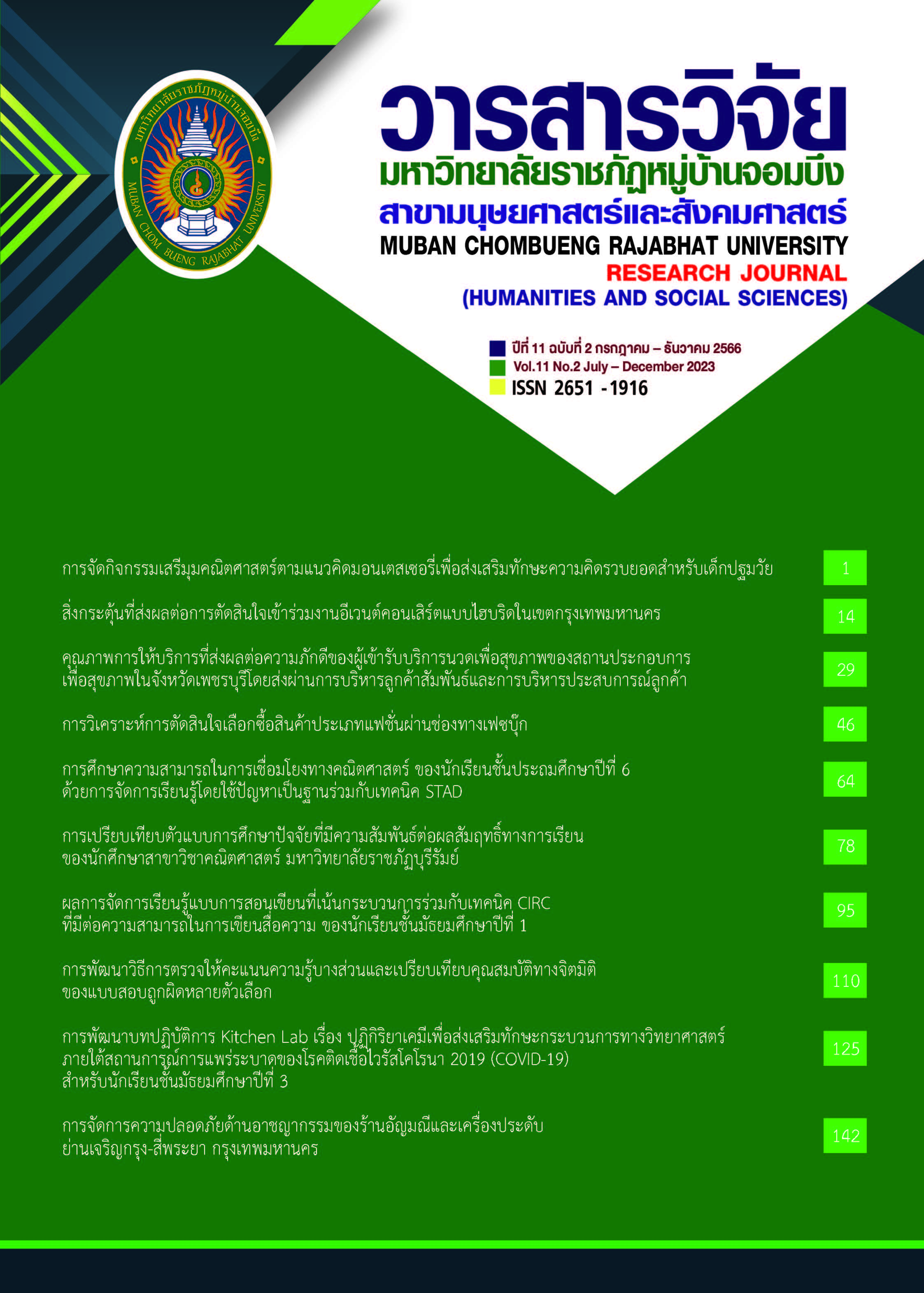การศึกษาความสามารถในการเชื่อมโยงทางคณิตศาสตร์ ของนักเรียนชั้นประถมศึกษา ปีที่ 6 ด้วยการจัดการเรียนรู้โดยใช้ปัญหาเป็นฐานร่วมกับเทคนิค STAD
คำสำคัญ:
ความสามารถในการเชื่อมโยงทางคณิตศาสตร์, การจัดการเรียนรู้โดยใช้ปัญหาเป็นฐาน, เทคนิค STADบทคัดย่อ
การวิจัยนี้เป็นการวิจัยกึ่งทดลอง มีวัตถุประสงค์เพื่อ 1) เปรียบเทียบความสามารถใน
การเชื่อมโยงทางคณิตศาสตร์ ของนักเรียนชั้นประถมศึกษาปีที่ 6 ก่อนและหลังได้รับการจัดการเรียนรู้โดยใช้ปัญหาเป็นฐานร่วมกับเทคนิค STAD 2) เปรียบเทียบความสามารถในการเชื่อมโยงทางคณิตศาสตร์ ของนักเรียนชั้นประถมศึกษาปีที่ 6 หลังได้รับการจัดการเรียนรู้โดยใช้ปัญหาเป็นฐานร่วมกับเทคนิค STAD กับเกณฑ์ร้อยละ 70 ของคะแนนเต็ม กลุ่มตัวอย่างที่ใช้ ได้แก่ นักเรียนชั้นประถมศึกษาปีที่ 6 โรงเรียนบางโพธิ์ใหม่ สังกัดสำนักงานเขตพื้นที่การศึกษาประถมศึกษาปทุมธานี เขต 1 ภาคเรียนที่ 2 ปีการศึกษา 2563 จำนวน 20 คน โดยการสุ่มแบบหลายขั้นตอน เครื่องมือที่ใช้ คือ 1) แผนการจัดการเรียนรู้โดยใช้ปัญหาเป็นฐานร่วมกับเทคนิค STAD จำนวน 10 แผน ใช้เวลา 20 ชั่วโมง ซึ่งมีความเหมาะสมในระดับมากที่สุด 2) แบบทดสอบวัดความสามารถในการเชื่อมโยงทางคณิตศาสตร์ มีค่าความเชื่อมั่นเท่ากับ 0.74 สถิติที่ใช้ในการวิจัย คือ ค่าร้อยละ ค่าเฉลี่ย ค่าส่วนเบี่ยงเบนมาตรฐาน การทดสอบค่าทีแบบกลุ่มเดียว และการทดสอบค่าทีแบบกลุ่มตัวอย่างที่ไม่เป็นอิสระจากกัน
ผลการวิจัยพบว่า 1) ความสามารถในการเชื่อมโยงทางคณิตศาสตร์ ของนักเรียนชั้นประถมศึกษาปีที่ 6 หลังได้รับการจัดการเรียนรู้โดยใช้ปัญหาเป็นฐานร่วมกับเทคนิค STAD สูงกว่าก่อนได้รับการจัดการเรียนรู้โดยใช้ปัญหาเป็นฐานร่วมกับเทคนิค STAD อย่างมีนัยสำคัญทางสถิติที่ระดับ 0.05 2) ความสามารถในการเชื่อมโยงทางคณิตศาสตร์ ของนักเรียนชั้นประถมศึกษาปีที่ 6 หลังได้รับการจัดการเรียนรู้โดยใช้ปัญหาเป็นฐานร่วมกับเทคนิค STAD สูงกว่าเกณฑ์ร้อยละ 70 ของคะแนนเต็ม อย่างมีนัยสำคัญทางสถิติที่ระดับ 0.05 ( = 16.80 จากคะแนนเต็ม 20 คะแนน และ
S.D. = 1.98)
เอกสารอ้างอิง
กระทรวงศึกษาธิการ. (2551). หลักสูตรแกนกลางการศึกษาขั้นพื้นฐาน พุทธศักราช 2551. กรุงเทพฯ: โรงพิมพ์ชุมนุมสหกรณ์การเกษตรแห่งประเทศไทยจำกัด.
ครองทรัพย์ เป็งขวัญ และมนกรณ์ วัฒนทวีกลุ. (2560). การพัฒนาทักษะการเชื่อมโยงทางคณิตศาสตร์และทักษะการแก้ปัญหาทางคณิตศาสตร์ด้วยการจัดกิจกรรมการเรียนรู้โดยใช้ปัญหาเป็นฐาน. วิทยานิพนธ์การศึกษามหาบัณฑิต สาขาวิชาหลักสูตรและการสอน มหาวิทยาลัยอุบลราชธานี.
ทิศนา แขมมณี. (2561). ศาสตร์การสอน : องค์ความรู้เพื่อการจัดกระบวนการเรียนรู้ที่มีประสิทธิภาพ. พิมพ์ครั้งที่ 21. กรุงเทพฯ: สำนักพิมพ์แห่งจุฬาลงกรณ์มหาวิทยาลัย.
นุชนารถ ทองกระจ่าง. (2556). การพัฒนาทักษะการเชื่อมโยงทางคณิตศาสตร์ เรื่อง ความน่าจะเป็นด้วยกิจกรรมการเรียนรู้ แบบใช้ปัญหาเป็นฐานสําหรับนักเรียนชั้น มัธยมศึกษาปีที่ 3. วิทยานิพนธ์การศึกษามหาบัณฑิต สาขาวิชาหลักสูตรและการสอน มหาวิทยาลัยบูรพา.
บุญชม ศรีสะอาด. (2545). การวิจัยเบื้องต้น. พิมพ์ครั้งที่ 7. กรุงเทพฯ: สุวีริยาสาสน์.
ล้วน สายยศ และอังคณา สายยศ. (2539). เทคนิคการวัดผลการเรียนรู้. กรุงเทพฯ: สุวิริยาสาส์น.
วทันยา กฤตติกานนท์. (2562). การศึกษาผลสัมฤทธิ์ทางการเรียนและความสามารถในการสื่อสารทางคณิตศาสตร์ ของนักเรียนชั้นประถมศึกษาปีที่ 3 โดยการจัดการเรียนรู้แบบการใช้สมองเป็นฐาน (BBL) ร่วมกับเทคนิค STAD. วิทยานิพนธ์หลักสูตรและการสอน มหาวิทยาลัยราชภัฏวไลยอลงกรณ์ ในพระบรม ราชูปถัมภ์.
สถาบันทดสอบทางการศึกษาแห่งชาติ. (2563). ผลการทดสอบทางการศึกษาระดับชาติ (O-NET) ปีการศึกษา 2562
สถาบันส่งเสริมการสอนวิทยาศาสตร์และเทคโนโลยี. (2555). ทักษะ/กระบวนการทางคณิตศาสตร์. กรุงเทพฯ: กระทรวงศึกษาธิการ.
สุพรรณิกา เอื้อศิลป์. (2559). การพัฒนาความสามารถในการแก้ปัญหาทางคณิตศาสตร์ และความสามารถในการให้เหตุผลทางคณิตศาสตร์ ด้วยการจัดการเรียนรู้ โดยใช้ปัญหาเป็นฐาน (PBL) เรื่อง ข้อมูลข่าวสารและค่าสถิติ ของนักเรียนชั้นมัธยมศึกษาปีที่ 3 โรงเรียนท่าด้วงพิทยาคม. การประชุมสัมมนาวิชาการ(Proceedings) การนำเสนอผลงานวิจัยระดับชาติ เครือข่ายบัณฑิตศึกษา มหาวิทยาลัยราชภัฏภาคเหนือ. ครั้งที่ 17. หน้าที่ 161-173.
Boaler, J. (1998). Open and closed mathematics: Student experiences and understandings. Journal for research in mathematics education. 29(1). 41-62.
White III, H. B. (1996). Dan tries problem‐based learning: a case study. To improve the academy. 15(1). 75-91.
ดาวน์โหลด
เผยแพร่แล้ว
รูปแบบการอ้างอิง
ฉบับ
ประเภทบทความ
สัญญาอนุญาต
ลิขสิทธิ์ (c) 2023 วารสารวิจัยมหาวิทยาลัยราชภัฏหมู่บ้านจอมบึง สาขามนุษยศาสตร์และสังคมศาสตร์

อนุญาตภายใต้เงื่อนไข Creative Commons Attribution-NonCommercial-NoDerivatives 4.0 International License.
วารสาร TCI อยู่ภายใต้การอนุญาต Creative Commons Attribution-NonCommercial-NoDerivatives 4.0 International (CC BY-NC-ND 4.0) เว้นแต่จะรุบุไว้เป็นอย่างอื่นโปรดอ่านหน้านโยบายของเราสำหรับข้อมูลเพิ่มเติมเกี่ยวกับการเช้าถึงแบบเปิด ลิขสิทธิ์ และการอนุญาต



